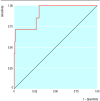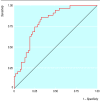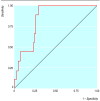Reliability of N-terminal pro-brain natriuretic peptide assay in diagnosis of heart failure: cohort study in representative and high risk community populations
- PMID: 12077039
- PMCID: PMC116449
- DOI: 10.1136/bmj.324.7352.1498
Reliability of N-terminal pro-brain natriuretic peptide assay in diagnosis of heart failure: cohort study in representative and high risk community populations
Abstract
Objective: To investigate the performance of a novel assay for N-terminal pro-brain natriuretic peptide (NT-proBNP) in diagnosing heart failure in various randomly selected general and high risk community populations.
Design: Community cohort study (substudy of the echocardiographic heart of England screening study).
Setting: Four randomly selected general practices in the West Midlands of England.
Participants: 591 randomly sampled patients over the age of 45, stratified for age and socioeconomic status and falling into four cohorts (general population, patients with an existing clinical label of heart failure, patients prescribed diuretics, and patients deemed at high risk of heart failure).
Main outcome measure: Sensitivity, specificity, positive and negative predictive values, likelihood ratios, and area under receiver operating characteristic curve for NT-proBNP assay in the diagnosis of heart failure.
Results: For NT-proBNP in the diagnosis of heart failure in the general population (population screen), a level of >36 pmol/l had a sensitivity of 100%, a specificity of 70%, a positive predictive value of 7%, a negative predictive value of 100%, and an area under the receiver operating characteristic curve of 0.92 (95% confidence interval 0.82 to 1.0). Similar negative predictive values were found for patients from the three other populations screened.
Conclusions: This NT-proBNP assay seems to have value in the diagnosis of heart failure in the community. High negative predictive values indicate that the assay's chief use would be to rule out heart failure in patients with suspected heart failure with normal concentrations of NT-proBNP. Positive results may identify patients who need cardiac imaging.
Figures




References
-
- Davies MK, Hobbs FDR, Davis RC, Kenkre JE, Roalfe AK, Hare R, et al. Prevalence of left ventricular systolic dysfunction and heart failure in the general population: main findings from the ECHOES (echocardiographic heart of England screening) study. Lancet. 2001;358:439–445. - PubMed
-
- Ho KKL, Anderson KM, Kannel WB, Grossman W, Levy D. Survival after onset of congestive heart failure in Framingham heart study subjects. Circulation. 1993;88:107–115. - PubMed
-
- Davis R, Hobbs FDR, Kenkre JE, Roalfe AK, McLeod S, Hare R, et al. Quality of life in heart failure, as measured by SF-36 health status questionnaire. Eur Heart J. 1998;19:S639.
-
- Hobbs FDR, Jones MI, Allan TF, Wilson S, Tobias R. European survey of primary care physician perceptions on heart failure diagnosis and management (Euro-HF) Eur Heart J. 2000;21:1877–1887. - PubMed
Publication types
MeSH terms
Substances
LinkOut - more resources
Full Text Sources
Other Literature Sources
Medical
Research Materials
